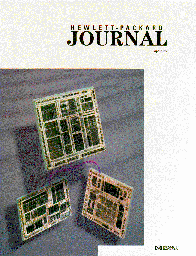
Multimedia capability is rapidly becoming a standard feature in today's
workstations. In this issue we have nine articles that describe just such
a workstation, the HP 9000 Model 712. The Model 712 is an entry-level workstation
with high-performance features that make it an an excellent platform for multimedia
tools and applications. The article on page 6
provides an overview of the Model 712, showing how the system is based
on three VLSI chips: a multimedia-enhanced PA-RISC processor, the PA 7100LC,
a highly integrated I/O chip, and a high-performance graphics chip.
Flawless execution of a product's development is not the only factor that
ensures a product's success. Defining the correct feature set and choosing
the right design methodologies are just as important as the schedule. The article
on page 12 describes
how the design team for the PA 7100LC processor used this philosophy to guide
the design decisions they made in developing the CPU chip, and the article
on page 23 describes
how these design decisions impacted the methodologies used to create, verify,
debug, and test the processor chip.
Low manufacturing cost was one of the main goals for the Model 712 workstation.
The article on page 36
describes how the Model 712's I/O subsystem was designed with with this goal
in mind. The I/O chip, called LASI, which is an acronym for the two major
pieces of functionality on the chip, LAN and SCSI, integrates several I/O functions
on one chip. Both the LAN and SCSI designs were purchased from outside vendors
and imported into the HP IC design process at the artwork and netlist levels
respectively.
Besides performance and functionality, low manufacturing cost was also a
primary goal for the graphics chip described in the article on page 43.
This was achieved by extracting as much performance and functionality as possible
from readily available technology and integrating components such as the color
lookup table and the frame buffer onto one chip. One of the features incorporated
on the graphics chip is a technology called HP Color Recovery, which is described
in the article on page 51.
Using a low-cost 8-bit frame buffer and HP Color Recovery, the graphics chip
can display images that are in many cases visually indistinguishable from those
of a 24-bit frame buffer costing three times more.
The combination of software and hardware optimizations, including the implementation
of a small set of PA-RISC multimedia software instructions enable the video
player in the HP MPower 2.0 product to play back MPEG compressed video at real-time
rates of up to 30 frames per second. As the article on page 60
explains, this is the first implementation in which real-time MPEG video decompression
has been achieved via software running on a general-purpose processor. The
multimedia enhancements allow four parallel operations per cycle by partitioning
each of the 32-bit ALUs.
Integrating telephone capabilities on a workstation is a natural step in
the evolution of the electronic office. The HP TeleShare option card for the
Model 712 workstation, which is described in the article on page 69,
represents HP's first telephony product. HP TeleShare provides two-line support,
with each line configurable for voice, fax, or data.
The product design for the Model 712, described in the article on page 75, shows how a design
with no fasteners and using environmentally friendly materials and low-cost
parts can provide excellent manufacturability and customer ease of use.
The PA 7100LC processor and the LASI chip are also used in a series of low-end
multiuser business servers, including the HP 9000 Series 800 Models E23, E35,
E45, and E55 and the HP 3000 Series 908, 918, 928, and 938. The article on
page 79 gives an overview
of the architecture of these products and the process the development team
went through to meet their time-to-market goals.
In today's global economy users must have seamless access to applications
and data that might be thousands of miles from from where they are located.
The article on page 85
describes a tool called HP Distributed Smalltalk, which provides an object-oriented
environment for the rapid development and deployment of multiuser, enterprise-wide
distributed applications. Based on the object-oriented model, HP Distributed
Smalltalk contains the objects that enable developers to construct applications
that provide such things as easy access to information across the enterprise,
dynamic interaction with other users on the network, insulation from differences
in operating environments, interoperability, and code reuse. The article on
page 93 describes an
application that was built with HP Distributed Smalltalk. The application,
HP Software Solution Broker, is a client-server system that gives HP's worldwide
technical consultants easy access to the latest HP and non-HP software products
and tools for customer demonstrations and prototyping.
Two papers in this issue are from the 1994 HP Design Technology Conference,
a forum for the exchange of ideas, best practices, and results among engineers
involved in the development and application of integrated circuit design technologies.
``After trying techniques that did not provide enough information to track
down the root cause of a failure in the FPALU of the PA 7100LC processor, the
design team decided to use a methodology called voltage contrast imaging to
find the problem. Voltage contrast imaging (page 102)
allows visual tracking of logical level problems to their source on operating
circuits using a scanning electron microscope. " In many IC design centers
today design for testability (DFT) is not just an abstract goal but a necessity.
The article on page 107
describes how a design team faced with the need to test over twenty new ASIC
components going into four different workstation and multiuser computer models
formed a DFT team to develop a common system-level DFT architecture so that
subsystem parts could be shared without affecting the manufacturing test flow.
C.L. Leath
Associate Editor
|